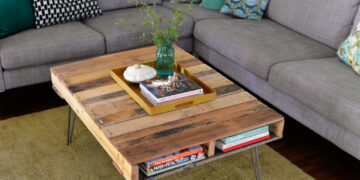The Artistic Odyssey: Unveiling the Genesis of Exquisite Furniture Creations
Furniture holds a unique place in our lives, as it not only serves a functional purpose but also enhances the aesthetics of our living spaces. Within the vast realm of furniture design, certain pieces transcend time, becoming iconic symbols of innovation, style, and craftsmanship.
These iconic furniture pieces are the result of a meticulous journey that begins with a simple sketch and culminates in their grandeur being showcased in prestigious showrooms around the world.
Definition of Iconic Furniture Pieces
An iconic furniture piece can be defined as an object that has achieved recognition beyond its utilitarian value, standing as a timeless symbol of design excellence. Such pieces often become emblematic representations of an era or a particular designer’s vision.
They possess inherent qualities that captivate and inspire, captivating generations with their beauty and functionality. Iconic furniture pieces are characterized by their ability to transcend trends and remain relevant across periods.
They embody innovative design concepts or incorporate groundbreaking techniques that push the boundaries of what is possible within the realm of furniture design.
The Importance of Understanding the Journey from Sketch to Showroom
To truly appreciate iconic furniture pieces, one must delve into the process behind their creation. Understanding the journey from sketch to showroom highlights not only the immense creativity involved but also sheds light on the craftsmanship and dedication required to bring these objects into existence.
By understanding this journey, we gain insight into how designers draw inspiration from various sources, such as nature, art movements, and cultural influences.
We come to appreciate how these initial sparks of inspiration are translated onto paper through sketches—visual representations capturing ideas before they materialize. This article aims to provide an in-depth exploration of each stage of this journey, from initial inspiration to transforming sketches into detailed designs through technical drawings and prototyping.
We will also examine how collaboration with skilled craftsmen and artisans helps refine the design, as well as the complex manufacturing processes that turn these sketches into tangible masterpieces.

The Design Process: From Inspiration to Sketch
Sources of inspiration for furniture designers
Every remarkable piece of furniture originates from a wellspring of inspiration, driving designers to create functional and aesthetically pleasing forms. One prominent source is the natural world, which offers an abundance of organic shapes and textures.
The sinuous curves of a river or the intricate patterns found in leaves can stimulate ideas that translate into unique furniture designs. Additionally, art movements and historical references act as catalysts for creativity.
The Art Nouveau movement, for instance, with its emphasis on flowing lines and elaborate ornamentation, has influenced numerous furniture designs throughout history.
Cultural influences and trends are also significant sources of inspiration; they reflect the spirit of a particular time or place and can be seen in the fusion of traditional craftsmanship with modern design elements.
Sketching is the initial step in the design process
Sketching serves as the foundation upon which furniture designers breathe life into their ideas. It is a fluid medium through which concepts are visualized before evolving into tangible forms.
Capturing these initial ideas on paper or digitally is crucial to preserving their essence and exploring various possibilities without limitations. Sketches allow designers to experiment with different shapes, proportions, and materials, enabling them to refine their vision gradually.
By sketching multiple iterations, they can analyze each variation’s potential impact on functionality, aesthetics, ergonomics, and overall design coherence. The freedom that sketching provides allows designers to push boundaries creatively while still maintaining control over every detail—a crucial phase in translating imagination into reality while ensuring optimal results.
Technical Drawings as Blueprints for Construction
In the journey from sketch to showroom, technical drawings play a crucial role in transforming ideas into tangible furniture pieces. These detailed blueprints serve as a roadmap for construction, ensuring precision and accuracy at every step of the manufacturing process.
Utilizing Computer-Aided Design (CAD) software, designers can create digital representations of their designs, allowing for precise measurements and specifications. Such software enables designers to visualize their concepts from multiple angles, facilitating the exploration of various design iterations before settling on a final blueprint.
Incorporating Ergonomic Considerations for Comfort and Functionality
Great furniture not only captivates with its aesthetics but also ensures optimum comfort and functionality. To achieve this harmony between form and function, designers must carefully consider ergonomic principles during the translation of sketches into detailed designs.
Understanding human ergonomics allows designers to create furniture that adapts seamlessly to the human body’s natural movements and posture, promoting healthy sitting or lounging experiences. By integrating ergonomic considerations into technical drawings, designers can refine dimensions, angles, and curves to optimize user comfort while maintaining an appealing aesthetic.

Creating Prototypes to Test Design Feasibility
Prototyping is an integral part of the design process, as it allows designers to test the feasibility of their ideas before moving forward with production. Through prototyping, furniture designers can bring their sketches to life using materials that closely resemble those intended for the final product.
This hands-on approach offers invaluable insights into potential design flaws or weaknesses that may arise during real-world use. It also provides an opportunity for designers to receive feedback from users or clients regarding comfort, functionality, and overall design appeal.
Materials Selection Based on Durability, Aesthetics, and Sustainability
When creating prototypes, careful consideration is given to selecting appropriate materials that align with the envisioned design’s characteristics. Furniture designers prioritize materials for their durability, ensuring that the final product withstands the test of time. Simultaneously, aesthetics play a significant role in material selection as they contribute to the overall visual appeal of the piece.
Additionally, designers are increasingly emphasizing sustainability by opting for eco-friendly and responsibly sourced materials in their designs. This conscious approach helps reduce environmental impact while meeting consumer demands for sustainable products.
Iterative Process of Refining Design Through Multiple Prototypes
Creating prototypes is not a one-time endeavour but involves an iterative process aimed at refining and perfecting the design. Each prototype serves as an opportunity for designers to test different variations, assess functionality, and make adjustments accordingly.
Through multiple iterations and refinements, designers can enhance every aspect of their furniture pieces – from structural integrity to aesthetic details – until they achieve a harmonious balance between form, function, and manufacturing practicality.
Fine-Tuning the Design: Collaborations with Craftsmen and Artisans
A: Collaboration with Skilled Craftsmen
To bring their designs to life with unparalleled craftsmanship, furniture designers often collaborate closely with skilled artisans specializing in various disciplines such as woodworking, metalworking, upholstery, and more. These collaborations enable the seamless integration of traditional craftsmanship techniques into contemporary design practices. By joining forces with these master craftsmen, designers ensure that their vision is executed with meticulous attention to detail and exceptional artistry.
1: Woodworkers, Metalworkers, Upholsterers…
Woodworkers possess exceptional skills in shaping wood into exquisite forms while ensuring structural integrity through precise joinery techniques. Metalworkers bring metal elements to life using fabrication methods like welding or forging, adding strength or decorative accents in line with design intentions.
Upholsterers skillfully manipulate fabrics, leather, and cushioning materials to provide both comfort and aesthetic refinement to furniture pieces. Each artisan contributes their expertise, elevating the final product through their mastery of a specific craft.
2: Merging Traditional Craftsmanship with Contemporary Design Elements
Collaborations between skilled craftsmen and furniture designers create a platform for the seamless merger of traditional craftsmanship techniques with contemporary design elements. These collaborations not only honour the rich heritage of craftsmanship but also infuse it with fresh perspectives and innovative approaches. The result is furniture that embodies both timeless elegance and modern sensibilities, ultimately resonating with a broader range of consumers who appreciate the blend of tradition and innovation.
Manufacturing Process: Turning Designs into Reality
A: Selection of Appropriate Manufacturing Methods
Once a design has been fine-tuned and prototyped, the next step is selecting appropriate manufacturing methods that align with production goals. Often, mass production techniques are employed to create furniture pieces on a larger scale, ensuring wider availability for consumers.
This involves streamlining production processes through efficient manufacturing systems while maintaining consistent quality standards. However, for limited editions or bespoke pieces that require the utmost attention to detail or customization possibilities, handcrafted production methods are preferred.
1: Mass Production Techniques for Wider Availability
Mass production techniques enable furniture designers to reproduce their designs in larger quantities without compromising quality or affordability. Utilizing advanced machinery and assembly-line processes allows manufacturers to efficiently produce furniture pieces that maintain consistency in design details while meeting market demands on a broader scale.
2: Handcrafted Production for Limited Editions or Bespoke Pieces
For exclusive limited editions or bespoke commissions where meticulous attention to detail is paramount, handcrafted production methods are favoured over mass production techniques. Skilled artisans meticulously handcraft each piece, paying extraordinary attention to every curve, joint, and surface finish.
This artisanal approach ensures the highest level of craftsmanship and allows for customization options tailored to individual preferences, resulting in truly unique and personalized furniture pieces.
B: Quality Control Measures
In the manufacturing process of iconic furniture pieces, quality control is an essential aspect to guarantee the consistent production of high-quality products. Stringent quality control measures are implemented throughout each stage of manufacturing, ensuring that every detail adheres to the designer’s vision and meets rigorous standards.
From material selection and sourcing to construction techniques and finishes, comprehensive quality checks are performed to identify any deviations from the desired specifications. By upholding stringent quality control measures, manufacturers can instil confidence in consumers that they are investing in furniture pieces built to stand the test of time.
Conclusion
In this journey from sketch to showroom, we witness how iconic furniture pieces come into existence through a meticulous process involving technical drawings, prototyping, collaborations with skilled artisans, and careful manufacturing. Furniture designers bring their sketches alive by incorporating ergonomic considerations for comfort and functionality while translating them into detailed designs using CAD software.
Prototyping then allows refinement through multiple iterations until design feasibility is achieved. Collaborations with craftsmen merge traditional craftsmanship with contemporary design elements while attention to detail exemplifies fine-tuning in craftsmanship.
Selection of appropriate manufacturing methods ensures wider availability or handcrafted exclusivity while maintaining stringent quality control measures for a remarkable final product. With passion and dedication permeating every stage of this journey, designers create timeless furniture that enhances our living spaces with beauty and functionality—a testament to human creativity shaping the world we inhabit.













